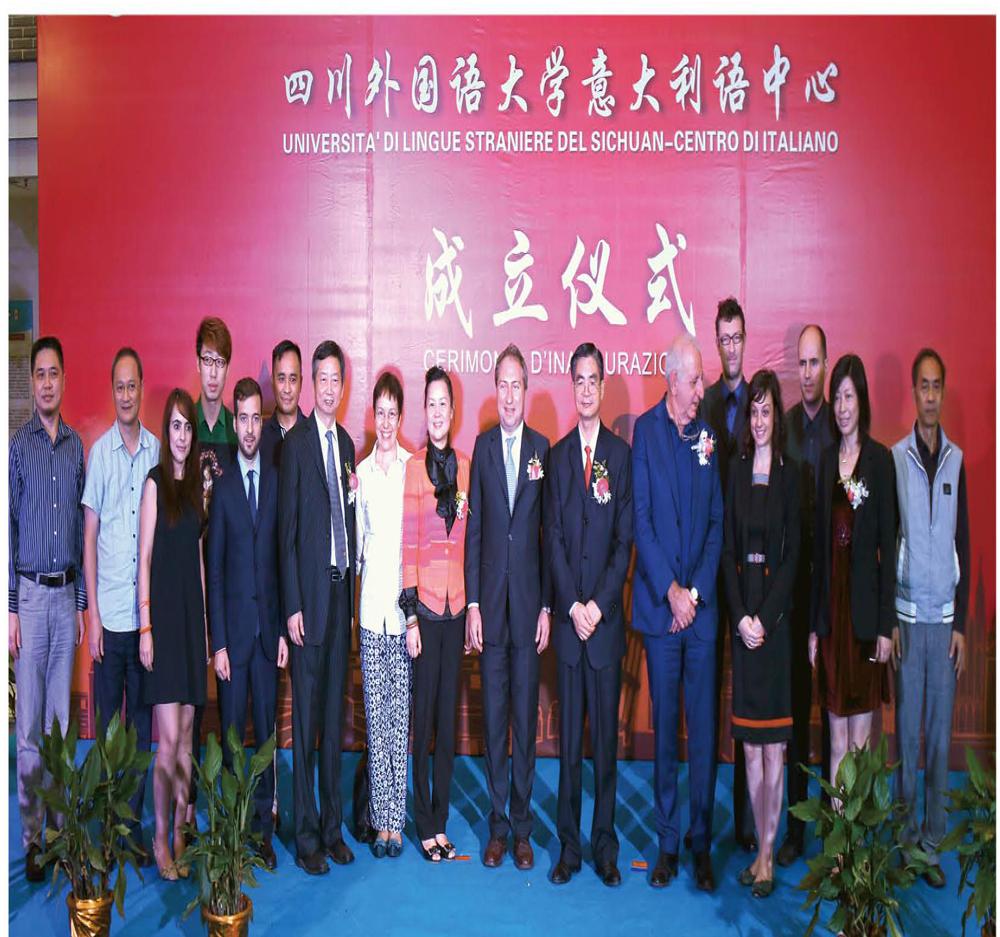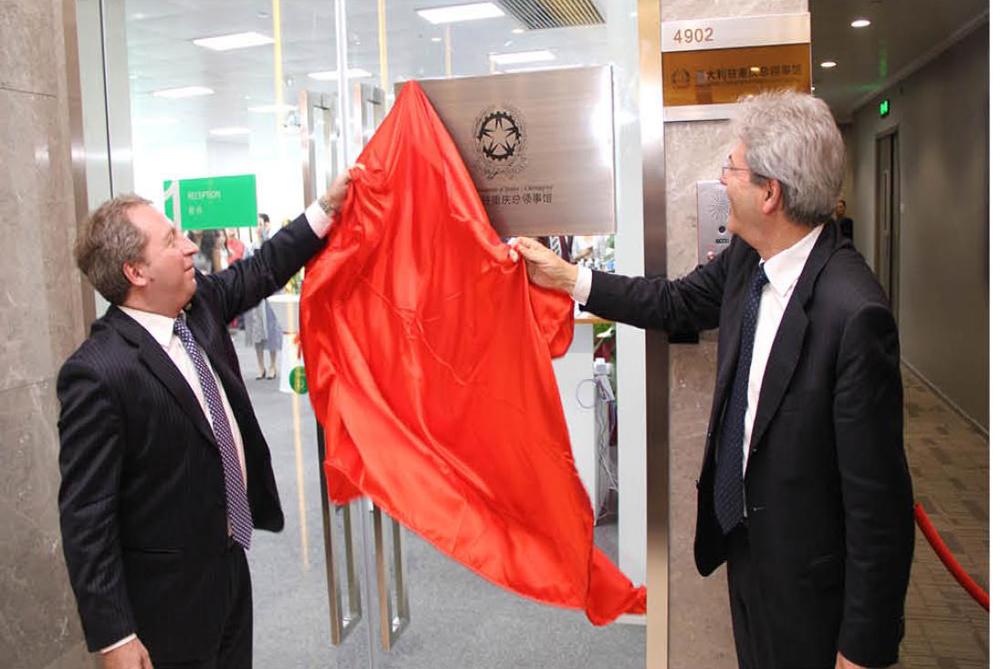重庆与意大利交往历史与展望
2020-08-31李书竹
李书竹



2013年12月30日,意大利驻重庆总领事馆开馆。这是继上海、广州、香港后,意大利在中国设立的第四个领事馆,为意大利与中国西南地区架起沟通的桥梁,提供了更加广阔的平台。意大利总领馆选址重庆,其历史渊源与现实原因,是中意两国关系中值得探究的话题。
中意两国交往的历史,最早可追溯到汉朝与古代罗马帝国时期。马可·波罗、利玛窦等人远渡重洋来到中国的壮举,成为欧洲家喻户晓的故事。那么,他们的游历与中国西南地区究竟有什么关联?从中我们可以展望意大利在这一地区双边关系的进一步发展,以及双边合作的新机遇。
十三世纪马可·波罗有没有来过重庆?
意大利旅行家、商人马可·波罗曾通过丝绸之路,在元世祖忽必烈在位时来到中国,游历了十几年。回到威尼斯后,在一次海战中被俘,他在监狱里口述其旅行经历,由鲁斯蒂谦写出《马可·波罗游记》。主要内容是他在中国各地的见闻,详细记述了元朝时期的经济、文化、民情、风俗,记录下了当时西安、开封、南京、杭州、扬州、福州等地的繁荣景象。该书第一次较全面地将地大物博、文教昌明的中国形象展示在世人面前,对东西方互通了解有很大的贡献。
1258年,蒙古可汗蒙哥率兵进攻四川,攻至重庆合川钓鱼城时,遭到当地军民顽强抵抗。次年,蒙哥病逝,其弟忽必烈继位,进一步争夺以重庆为中心的四川沿江诸城。1278年,元军对重庆发起总攻,重庆遭到蒙古军破城……
若《马可·波罗游记》记载年份确凿,在重庆被元军攻下之后的两年,马可·波罗便南下开始了他在中国南部的游历。而重庆在唐宋时代,只是西南地区的一个普通州府,直至南宋晚期,在蒙古大军压境的形势之下,重庆才成为了川陕四路的驻节之地。因此,在受忽必烈派遣南下的马可·波罗的叙述中,有描写成都的句子,而成都以东300多公里的州城重庆却没有被提及。
开埠后及二战期间重庆成为中国重要的外交主场
开埠标志着重庆对外开放的开端。1891年,中英签订《烟台条约续增专条》,即《重庆通商条约》,重庆就此开埠,外国商船、洋行、医院、使领馆相继进入中国的西南腹地。1895年,中日《馬关条约》开重庆为通商口岸,重庆成为当时中国内陆最西端的开埠通商口岸。十余年间,英国 、法国 、日本 、美国、德国先后在重庆设立领事馆。
抗日战争爆发前,在中国的外交使节来自22个国家,包括8国大使:苏联、德国、美国、日本、法国、英国、意大利、比利时;11国特命公使及全权公使:古巴、葡萄牙、丹麦、波兰、荷兰、巴西、挪威、墨西哥、芬兰、瑞典、捷克斯洛伐克;1国代办:瑞士;2国临时代办:智利、秘鲁。
抗日战争全面爆发后,随着国民政府迁都重庆,各国驻中国使领馆和使节,分期分批以不同方式转至武汉,后逐步来到重庆。战时重庆对外交往的历史,大体可分为以下三个阶段:
第一阶段(1937—1940):10个国家同时在重庆设有使领馆。1937年“卢沟桥事变”后,日本大举侵略中国,直逼南京,形势危急。11月17日,国民政府主席林森率领国民政府撤离南京,并于3日后在武汉宣布迁都重庆,重庆正式担负起中国战时首都的责任。
据研究统计,到1940 年,共有10个国家同时在重庆设有使领馆,有大使馆7个:美国、英国、法国、苏联、德国、意大利、比利时;公使馆3个:荷兰、土耳其、墨西哥。
第二阶段(1941—1943):驻渝外国外交使领馆达到13个。抗日战争爆发后的一段时期,以美国为首的西方国家在中日战争中采取“中立”立场。随着日本侵华加剧,到1941年,西方对日本实施更多禁令。同年12月7日,日军突袭驻守在珍珠港的美国太平洋舰队,将中日之间的国家战争升级为两大对立阵营之间的全球战争。世界外交格局发生根本转变,中国加入同盟国组织。1941年7月1日,中国政府与德国、意大利断绝外交关系,两国外交官旋即离开重庆。随后断交的还有罗马尼亚和丹麦。中国在与轴心国断绝外交关系的同时,加强了与英联邦国家的联系,与加拿大、印度、埃及、伊朗和梵蒂冈建立了外交关系。
第三阶段(1943—1946):22个国家在重庆派驻外交使领馆。1943年是中国与盟友战时合作的顶峰之年。这一时期,在美国主导下,推动了废除西方国家与中国之间不平等条约的进程,同时将中国纳入“四大国”力量体系。
1943年初,美、英两国正式放弃在华治外法权。这一年,中国受邀参与了若干高级别国际峰会,享有了前所未有的国际地位。国民政府利用这一机遇,使几乎所有外国在重庆的外交使团都得以扩展或升至大使级关系。其中升格的有:波兰、荷兰、挪威、墨西哥、土耳其、加拿大、捷克斯洛伐克;新设大使馆的有:秘鲁、伊朗、阿根廷、意大利、智利、巴西。
改革开放后重庆及西南地区与意大利的交流合作
新中国成立以来,特别是改革开放以来,重庆经济建设取得了长足发展,作为中国重要的工业基地之一,已成为西南地区和长江上游的经济中心城市和重要的交通枢纽。这一时期,重庆与意大利在工业领域开展了系列合作。
2004年,国内摩托车民营企业的重要代表重庆宗申产业集团与国际摩托车行业的顶尖企业意大利比亚乔集团,合资成立宗申—比亚乔摩托车公司。该公司投资2亿元建成的摩托车生产基地,成为了比亚乔全球采购体系中的重要一环。
此后,重庆与意大利的合作不断深入。2005年,意大利菲亚特集团与重庆红岩汽车打造合资项目;2009年7月,重庆力帆实业(集团)进出口有限公司在意设立力帆意大利有限责任公司;2010年5月,意大利劳动和社会政策部部长毛里奇奥·萨科尼和经济发展部副部长阿道夫·乌尔索,率150家企业代表来渝考察,与上百家重庆企业成功对接,双方在汽车、能源、环保、消费食品、服装纺织、机械生产等多个领域洽谈合作。
2013年12月,意大利驻重庆总领事馆开馆,这是意大利在中国西南地区设立的首家领事馆,领区包括重庆、四川、贵州、云南。2014年1月,意大利驻重庆总领事馆与四川外国语大学签订框架性合作协议,将为川外学生提供培训、实习机会,为川外教职工提供科研交流、培训机会,共同开展文化交流与学术活动等。同年,受国家旅游局驻罗马办事处邀请,意大利国家电视台《GEO》节目摄制组赴中国上海、重庆、湖北等省市拍摄以“人与自然”为主题的电视纪录片,推广“美丽中国之旅”旅游形象。通过他们的镜头,洪崖洞、湖广会馆、长江索道,以及小面、火锅等重庆美景美食,生动地呈现在意大利观众的眼前。
2014年7月,時任意大利驻重庆总领事马非同邀请意大利国家电视台第一频道著名主持人Duilio Giammaria来渝采访,以《重庆》为名制作专题纪录片,重庆的经济社会发展成就尤其是中欧班列(渝新欧)引起了意大利工商界的关注。
2017年2月,意大利总统塞尔焦·马塔雷拉,携外交与国际合作部部长、基层设施与交通部部长、意大利驻华大使等40余人组成的政府代表团访问重庆。同年8月,在意大利驻重庆总领馆的推动下,两国政府签订协议成立重庆两江新区中意产业园,为意大利企业在中国西南地区开展贸易提供更加便利的环境。
意大利是欧洲的重要国家,而重庆处在“一带一路”和长江经济带的联结点上,是西部大开发的重要战略支点,正积极建设内陆开放高地,打造中西部国际交往中心。目前,意大利已经通过中欧班列(渝新欧)进行货物运输。同时,借助意大利驻重庆总领事馆这一平台,中国西南地区将与意大利在环保、消除贫困缩短贫富差距、农业、医疗等多个方面进一步加强合作。
作者单位/四川外国语大学 图片/市政府外办提供
编辑/贺煜
The consulate general of Italy in Chongqing was inaugurated on December 30, 2013. As the fourth Italian consulate general in China after the ones in Shanghai, Guangzhou and Hongkong, it serves as a bridge for the exchanges between Italy and southwest China. The historical origins and contemporary reasons for selecting Chongqing as its site is a topic worthy of discussion in China-Italy relations.
The history of exchanges between China and Italy dates back to the Han Dynasty and the ancient Roman Empire. The voyages of Marco Polo, Matteo Ricci and other Italians to China have become household stories in Europe. So, what is the connection between their voyages and southwest China? From the answer to this question, we may see the the prospect of further growth of bilateral relations in this region and new opportunities for bilateral cooperation.
Thirteenth century
Had Marco Polo ever been to Chongqing?
Marco Polo, an Italian traveler and businessman, traveled to China through the Silk Road during the reign of Kublai Khan, an emperor of Yuan Dynasty, and spent more than a decade in China. After returning to Venice and upon being captured in a naval battle, he told about his travel experience in prison, and Rustichello wrote about it and named it The Travels of Marco Polo. The Book mainly recorded Marco Polo's experience in China and described in detail the economy, culture and folk customs of the Yuan Dynasty, as well as the prosperity of Xi'an, Kaifeng, Nanjing, Hangzhou, Yangzhou, Fuzhou and some other places at that time. For the first time, it presented the image of China as a country with vast territory, abundant resources and highly-developed culture and education, making a great contribution to the mutual understanding between the East and the West.
In 1258, Mongke, the Mongolian Khan, attacked Sichuan with his troops and reached the Fishing Town of Hechuan in Chongqing, where they encountered fierce resistance from the local military and civilians. The ensuing year, Mongke died of illness and Kublai Khan, his younger brother, succeeded to the throne and further contended for the cities centered around Chongqing along the Yangtze River in Sichuan Province. In 1278, the Mongol army launched a general attack on Chongqing and seized the city…
If the dates recorded in The Travels of Marco Polo are correct, two years after Chongqing was occupied by the Mongol army, Marco Polo began his journey to the south of China. In the Tang and Song Dynasties, Chongqing was just an ordinary prefecture in southwest China. In the late Southern Song Dynasty, Chongqing became the garrison of Sichuan after being besieged by the Mongolian army. Therefore, in the description of Marco Polo, who was sent by Kublai Khan to the south, there were sentences describing Chengdu, while Chongqing, the prefecture around 300 km east of Chengdu, was not mentioned.
Opening-up as a commercial port and the World War II period
Chongqing becomes an important diplomatic hub for China
Port opening marked the beginning of Chongqing's opening-up. In 1891, China and the United Kingdom signed the Yantai Treaty Amendment, also known as the Commercial Treaty of Chongqing. Chongqing was hence opened up for trade, and foreign merchant ships, foreign firms, foreign hospitals, embassies and consulates successively entered Chongqing, the hinterland of southwest China. In 1895, China and Japan signed the Treaty of Shimonoseki and Chongqing was opened as a treaty port, making Chongqing the west-most port in inland China at that time. In the decade since then, Britain, France, Japan, the United States and Germany successively set up consulates in Chongqing.
Before the outbreak of the War of Resistance against Japanese Aggression, diplomatic envoys in China came from 22 countries, including 8 ambassadors from Soviet Union, Germany, United States, Japan, France, Britain, Italy and Belgium; 11 ministers extraordinary and ministers plenipotentiary from Cuba, Portugal, Denmark, Poland, the Netherlands, Brazil, Norway, Mexico, Finland, Sweden and Czechoslovakia; 1 consular agent from Switzerland; 2 interim consular agents from Chile and Peru.
After the war broke out, as the Nanjing KMT Government moved its capital to Chongqing, the embassies and consulates of various countries in China first moved to Wuhan, and then gradually moved to Chongqing. The history of Chongqing's foreign exchanges during the War can be generally divided into the following three stages:
Stage I (1937–1940): 10 countries set up embassies and consulates in Chongqing. After the "Lugou Bridge Incident" in 1937, Japan invaded China on a large scale and pushed Nanjing into a critical situation. On November 17, Lin Sen, the chairman of the Nanjing KMT Government, led the government to withdraw from Nanjing. Three days later, he announced in Wuhan that the capital would be moved to Chongqing, making Chongqing the official capital of China during the War.
According to statistics, by 1940, 10 countries had set up embassies and consulates in Chongqing, including embassies from United States, United Kingdom, France, Soviet Union, Germany, Italy and Belgium, and legations from the Netherlands, Turkey and Mexico.
Stage II (1941–1943): there were 13 embassies and consulates in Chongqing. During the period after the outbreak of the War, the western countries, led by the United States, maintained a neutral position in the War of Resistance against Japanese Aggression. As Japan's invasion of China intensified, the West imposed more bans on Japan by 1941. On December 7 of the same year, Japanese troops raided the United States Pacific Fleet garrisoned at Pearl Harbor, escalating the national war between China and Japan into a global war between two opposing camps. The pattern of diplomacy had undergone a fundamental change, and China joined the Allied Powers. On July 1, 1941, the Chinese government severed diplomatic relations with Germany and Italy, and the diplomats of the two countries left Chongqing immediately. Later, Chongqing severed diplomatic relations with Romania and Denmark. While severing diplomatic relations with the Axis Powers, China had strengthened its ties with the Commonwealth and established diplomatic relations with Canada, India, Egypt, Iran and Vatican.
Stage III (1943–1946): 22 countries stationed embassies and consulates in Chongqing. 1943 was the peak year of wartime cooperation between China and its allies. During this period, led by the United States, the process to abolish the unequal treaties between western countries and China was advanced and at the same time China was included in the power system of "Four Powers".
In early 1943, the United States and Britain formally gave up their extraterritorial jurisdiction in China. In this year, China was invited to several high-level international summits and enjoyed an unprecedented international status. The KMT government took advantage of this opportunity to expand or upgrade almost all foreign diplomatic missions in Chongqing to ambassadorial levels. The upgraded countries were Poland, the Netherlands, Norway, Mexico, Turkey, Canada, Czechoslovakia; and the countries who opened new embassies were Peru, Iran, Argentina, Italy, Chile and Brazil.
After the reform and opening up
Exchanges and cooperation between Chongqing and Italy
Since the founding of New China, especially since the reform and opening up, Chongqing has made great progress in economic construction. As one of China's important industrial bases, Chongqing has grown into an economic hub and an important transportation hub in southwest China and the upper reaches of the Yangtze River. During this period, Chongqing and Italy carried out a series of industrial cooperation.
In 2004, Zongshen Industrial Group, an important representative of domestic private motorcycle enterprises, and Piaggio Group, a top international motorcycle enterprise, jointly established Zongshen & Piaggio Motorcycle. The motorcycle production base built by the company, with an investment of 200 million yuan, has become an important part of Piaggio's global purchasing system.
Since then, the cooperation between Chongqing and Italy has been deepening. In 2005, Fiat Group and Chongqing Hongyan Automobile Co., Ltd. established a joint venture. In July 2009, Lifan Group Corporation set up Lifan (Italy) Co., Ltd. in Italy. In May 2010, Maurizio Sacconi, minister of labor and social policy of Italy, and Adolfo Urso, deputy minister of economic development, led a delegation of 150 entrepreneurs to visit Chongqing and successfully met and communicated with hundreds of Chongqing enterprises. The two sides discussed cooperation in automotive, energy, environmental protection, consumer food, clothing and textiles, machinery manufacturing and other fields.
In December 2013, the Consulate General of Italy in Chongqing, the first Italian consulate in southwest China, opened. The Consulate General covers the area of Chongqing, Sichuan, Guizhou and Yunnan. In January 2014, it signed a framework cooperation agreement with Sichuan International Studies University (SISU) to provide training and internship opportunities for SISU students, scientific research exchange and training opportunities for its faculty members, and jointly carry out cultural exchanges and academic activities. In the same year, at the invitation of the Rome office of the National Tourism Administration, the film crew of the Program GEO of the RAI went to Shanghai, Chongqing, Hubei and other provinces and cities of China to shoot a TV documentary with the theme of "Human and Nature" to promote the tourism image of "Journey to Beautiful China". Through these shots, Hongyadong, Huguang Guild Hall, Yangtze River Cableway, Chongqing spicy noodles, hotpot and other beautiful scenery and delicious food in Chongqing were vividly presented to the Italian audience.
In July 2014, Sergio Maffettone, the then consul general of Italy in Chongqing, invited Duilio Giammaria, a famous host of RAI Channel One, to Chongqing for an interview, and produced a documentary named Chongqing. The economic and social achievements of Chongqing, especially the China Railway Express (Yuxinou), attracted the attention of the Italian industrial and business communities.
In February 2017, Italian president Sergio Mattarella visited Chongqing with a government delegation of more than 40 officials, including the minister of foreign affairs and international cooperation, the minister of infrastructure and transportation, and the Italian ambassador to China. In August of the same year, under the promotion of the Consulate General of Italy in Chongqing, the two governments signed an agreement to establish Sino-Italian Industrial Park in Chongqing Liangjiang New Area, providing a more convenient environment for Italian enterprises to trade with southwest China.
Italy is an important country in Europe, and Chongqing, located at the junction of the Belt and Road and the Yangtze River Economic Belt, is an important strategic stronghold for the development of the western region. Chongqing is actively branding itself as the inland opening-up leader and an international communication center for the central and western regions. At present, Italy is already transporting goods through the China Railway Express (Yuxinou). At the same time, with the help of the Consulate General, southwest China will further strengthen cooperation with Italy in environmental protection, poverty eradication and narrowing of the gap between the rich and poor, agriculture, health care and other aspects.
Authors affiliation/Sichuan International Studies University
Editor/He Yu
